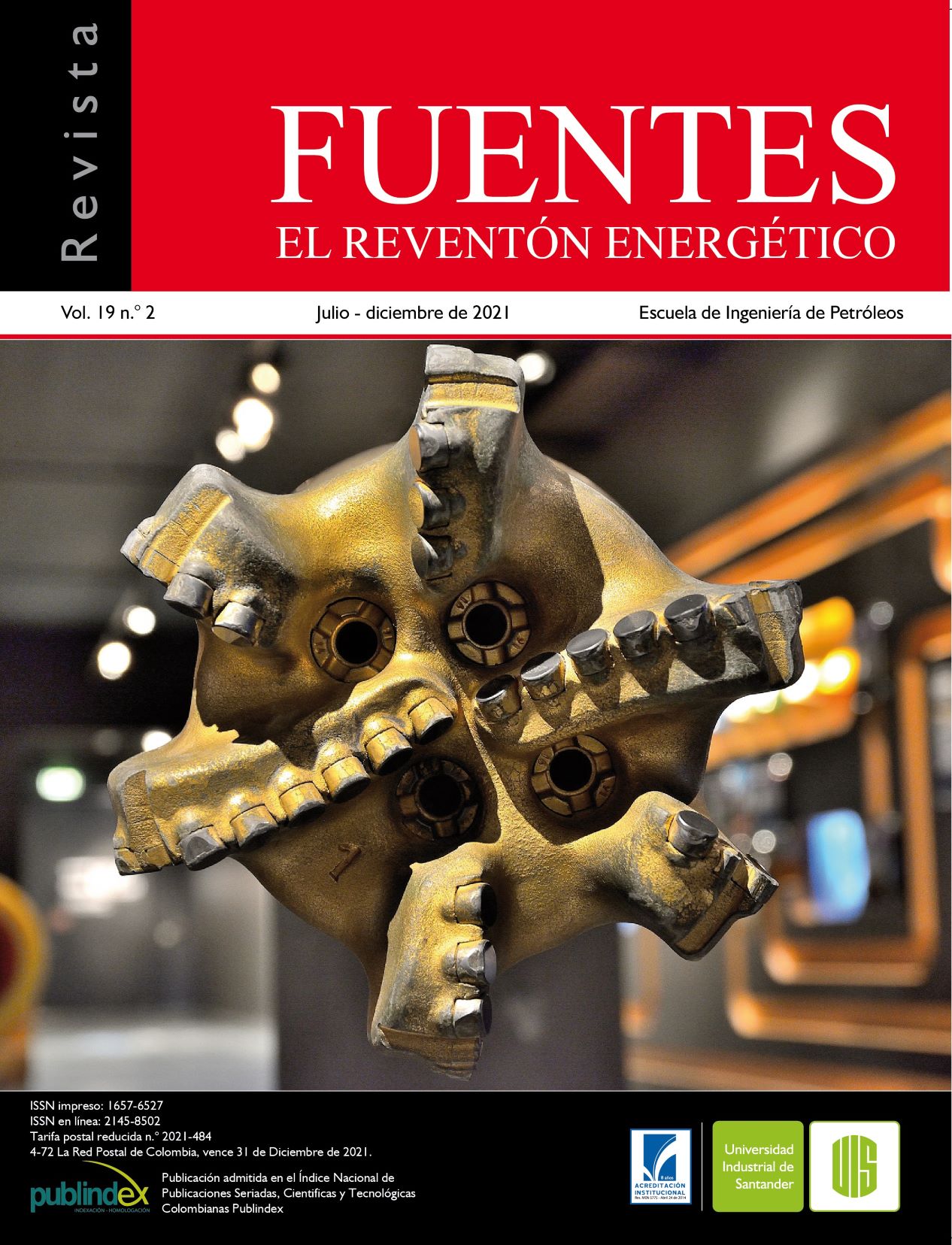Estimation of reserves and prospective resources of Coalbed methane (CBM) in Peru
Publicado 2021-12-24
Palavras-chave
- Coalbed Methane,
- Unconventional resources,
- Langmuir adsorption isotherm
Como Citar
Copyright (c) 2021 Universidad Industrial de Santander

Este trabalho está licenciado sob uma licença Creative Commons Attribution 4.0 International License.
Resumo
Methane and coal form together during carbonification, a process in which the biomass is converted by biological and geological forces into coal. Methane is adsorbed by the molecular structure of coal and is released by a simple desorption process when the water present in the fissures of the coal formation is dislodged. Although the development of these unconventional deposits of Coalbed Methane (CBM) has not been applied in Peru, there is a good prospect of CBM development in the Goyllarisquizga and Jatunhuasi formations.
Reserve estimation techniques include volumetric material balance, decrease curve analysis, simulation studies, and geophysical techniques. Entries for initially estimation of original gas in place (OGIP include geological parameters, specific parameters of carbon layer methane (CBM), and production history. Bituminous coal from the Goyllarisquizga and Jatunhuasi basins is very suitable for the exploration of CBM in terms of its depth of occurrence, the thickness of coal formation, coal reserve, and area extension. Consequently, the total gas that can be produced is 3 TSCF.
Downloads
Referências
- Administration, U. E. (n.d.). Coalbed methane production. Retrieved March 13, 2021, from US Energy Information.
- B.S., Ryan, B., & J.Cunninhham. (1991). Coalbed Methane production from the Pottsville formation at cedar cove field, Black Warrior basin, Alabama, U.S.A. In the Canadian coal and coalbed methane. Geoscience forum, 73.
- Báez-Serrano, P. J. (2020). Uso de nuevo propante en fracturamiento hidráulico de pozos tight gas en el piedemonte colombiano. Revista Fuentes, el reventón energético, 18(2), 57-67. doi:https://doi.org/10.18273/revfue.v18n2-2020004
- Bhanja, A. K., & Srivastava, O. P. (2008). A New Approach to Estimate CBM Gas Content from Well Logs. Oil and Natural Gas Corporation Ltd.(ONGC), Vadodara, India. Perth, Australia: Society of Petroleum Engineers.
- Bohorquez-Araque, A. &.-R. (2021). Feasibility analysis of the implementation of geothermal energy in waters associated for the production of hydrocarbons. Fuentes, el reventón energético, 19(1), 33-43. doi:https://doi.org/10.18273/revfue.v19n1-2021004
- Broggi, J. (1927). La industria carbonera en el centro del Perú. Síntesis de la minería peruana en el Centenario de Ayacucho, 1-93.
- Cárdenas, J. C., Castillo, R. D., Perez., E. R., & Tovar, J. J. (2014). Shale Plays: Pronósticos de produccion a partir de simulación predectiva. Revista Fuentes: El Reventón Energético, 12(1), 67-74.
- Carrascal Miranda, R., Matos Ávalos, C., & Silva Campos, O. (2000). Carbón en el Perú. Boletín, Instituto Geológico Minero y Metalúrgico (INGEMMET), Geología Económica, Lima.
- Clarkson, C. R., & Bustin, R. M. (2010). Coalbed Methane: Current Evaluation Methods, Future Technical Challenges . University of Calgary, University of British Columbia. Pittsburgh, Pennsylvania, USA: Society of Petroleum Engineers.
- Dhir, R., Dern Jr., R. R., & Mavor, M. J. (1991, December). Economic and Reserve Evaluation of Coalbed Methane Reservoirs. Journal Petroleum Technology, 1424-1518.
- Hernández Ramos, M., & Mejía González, R. F. (2014). Estimación de Reservas y Recursos Prospectivos de Coalbed Methane (CBM) en México. Tesis de Grado, Universidad Nacional Autónoma de México, División de Ingeniería en Ciencias de la Tierra, Ciudad de México.
- Johnson , R. C., & Finn, T. M. (2001). Potential for a Basin-Centered Gas Accumulation in the Raton Basin, Colorado and New Mexico. Bulletin, U.S. Department of Energy, U.S. Geological Survey, National Energy Technology Laboratory, Central Region, Denver, Colorado. Retrieved from http://geology.cr.usgs.gov/pub/bulletins/b2184-b/
- Kurnely, K., Tamtomo, B., Aprilian, S., Doria, I., & Pertamina DOH SBS. (2003). A Preliminary Study of Development of Coalbed Methane (CBM) in South Sumatra. Paper, Society of Petroleum Engineers, Jakarta, Indonesia.
- Langmuir, I. (1996). THE CONSTITUTION AND FUNDAMENTAL PROPERTIES OF SOLIDS AND LIQUIDS. (Vol. 38). Journal of the American Chemical Society.
- lnternational Committee for Coal Petrology. (1975). lnternational handbook of coal petrology (Second ed.). París, París, Francia: C.N.R.S.
- Luyo Quiroz, A. (2012). Visión futura del Carbón Peruano. Revista del Instituto de investigacion de la Facultad de minas, metalurgia y ciencias geograficas, 9.
- Megard, F. (1968). Geología del cuadrángulo de Huancayo. Boletín, Servicio de Geología Minera, Huancayo.
- Mukhopadhyay, P. K., Hatcher, P. G., & Rice, D. D. (1993). Hydrocarbons from Coal. AAPG, Studies in Geology, Twenty-one, 79-113.
- Murcia Paéz, A. R., & Sana Sanchez, A. (2012). Estudio de las propiedades para la caracterización de yacimientos de gas asociado a mantos de carbón. Tesis de Grado, Universidad Industrial de Santander, Facultad de IngenieríasFísico-Químicas, Escuela de Ingeniería de Petróleos, Bucaramanga.
- Ortega, J. (2008, November 3). Reservorios de Coalbed Methane (CBM). Universidad Nacional de Cuyo, 7.
- Page, J. S. (1960). Geología del carbón. En: Convención de Ingenieros de Minas del Perú. Anuales, Instituto de Ingenieros de Minas(6), 8-21.
- Peters, J., & Oil and Natural Gas Corp. Ltd. (2000). Evaluation Of Coalbed Methane Potential Of Jharia Basin, India. Paper, Society of Petroleum Engineers Inc., Brisbane, Australia.
- Petersen, C. R. (1978;1979). Coal resources of Peru. Geological Society of America, 35-42.
- Petersen, R., Kottlowski, F. E., Cross, A. T., & Meyerhoff, A. A. (1978). Coal resources of Peru. Geo. Soc. Am.(179), 35-42.
- Portilla, C. L.-B. (2021). Utilización de algoritmos genéticos para la optimización en el cálculo de variogramas basadas en celdas para la simulación de un yacimiento. Revista fuentes, el reventón energético, 19(I), 7-19. doi:https://doi.org/10.18273/revfue.v19n1-2021002
- Rahman, M. (2009). Coalbed Methane(CBM) Prospect in Jamalganj Coal Field, Bangladesh. Article of Presentation, University of Dhaka, Bangladesh, Department of Geology , Houston.
- Squarek, J., & Dawson, M. (2006, July 24). Coalbed methane expands in Canada. Oil & Gas Journal, 37-40.
- Steinmann, C. (1929). Geologie del Perú. Carl Winters Universitats-buchhandlung, Heidelberg.
- Swindell, G. S. (2007, Abril 17). Powder River Basin Coalbed Methane Wells - Reserves and Rates. Paper, Society of Petroleum Engineers Inc., Denver, Colorado.
- Wilson, J. (1963). Cretaceous Stratigraphy of Central Andes of Peru. Bull. Am. Asoc. Petrol. Geol., 47(1), 1-34.
